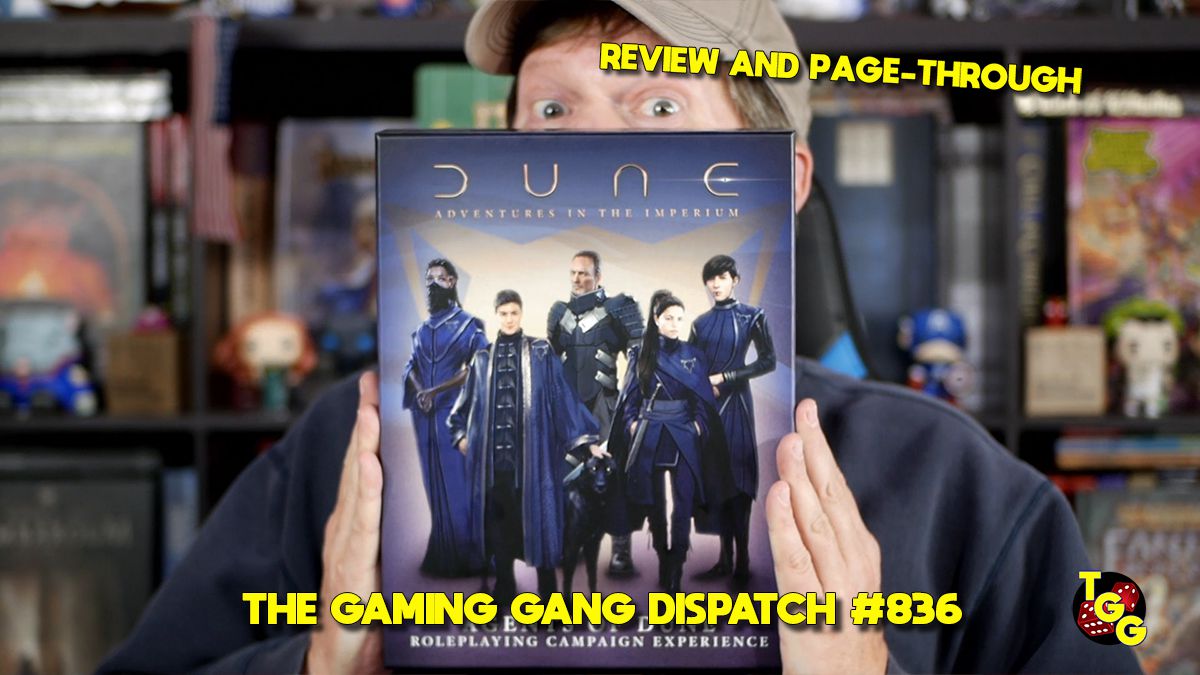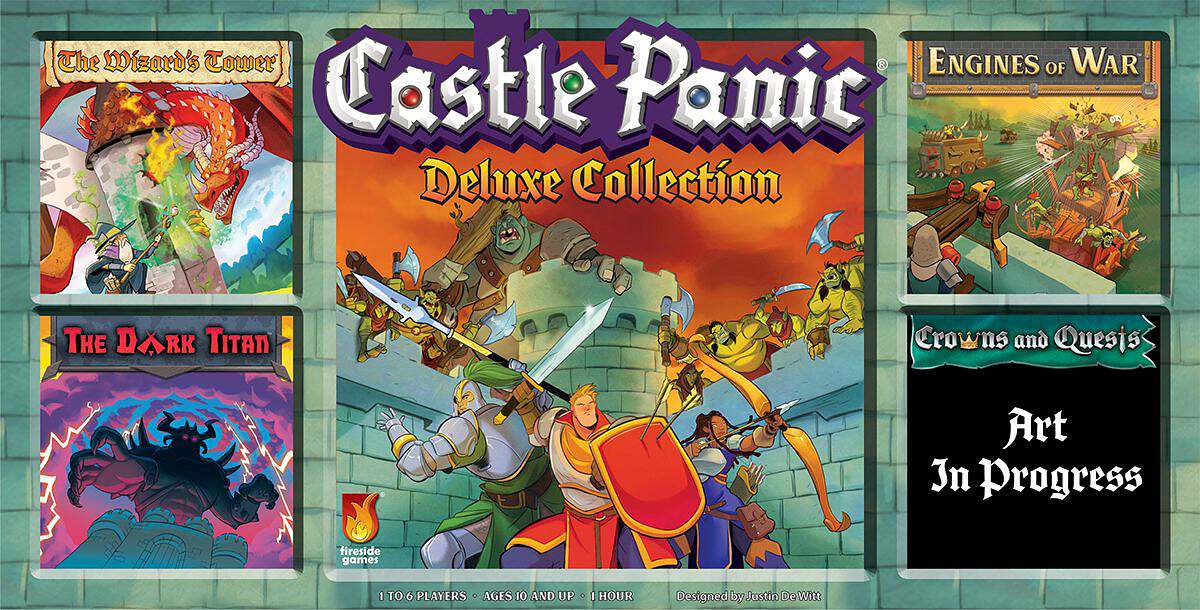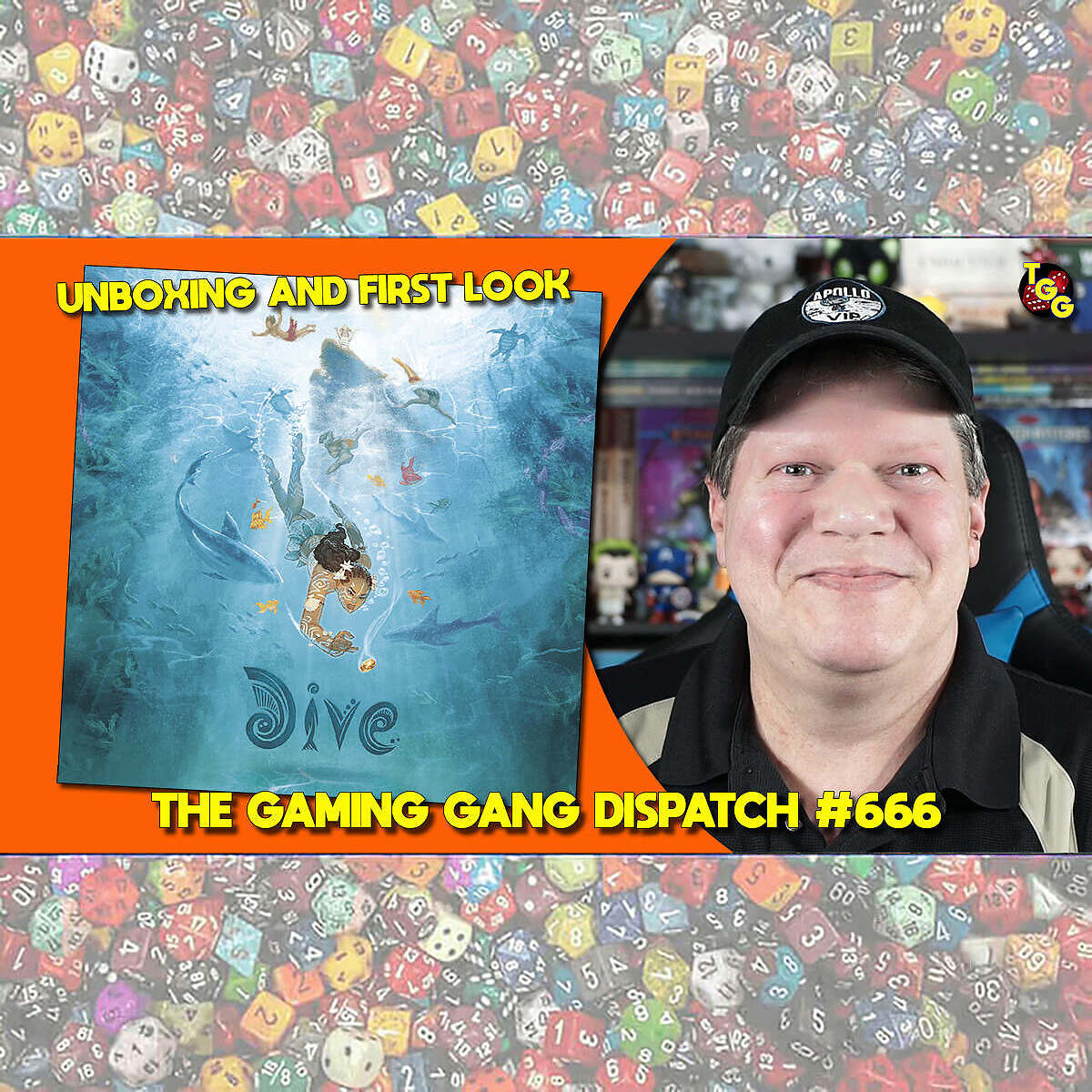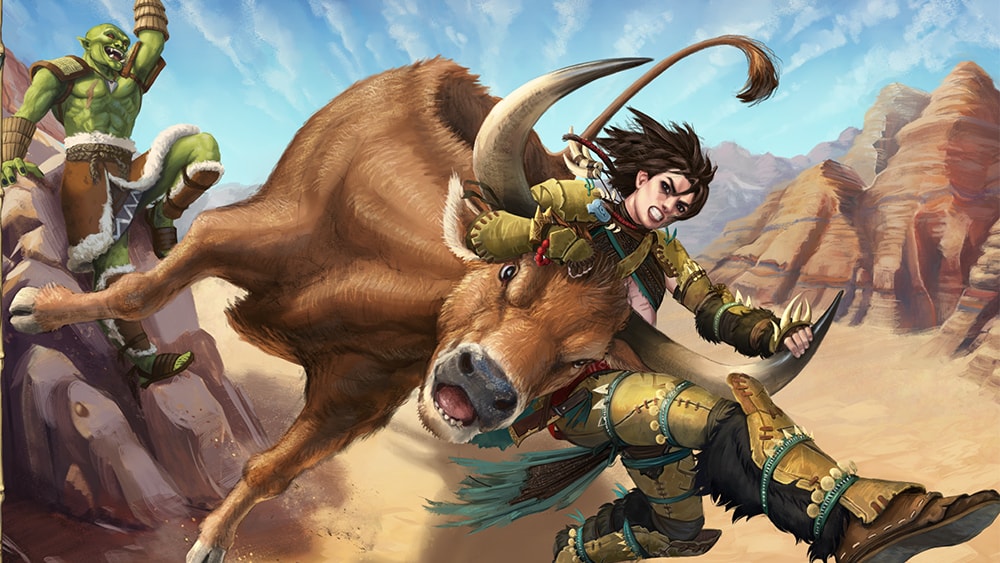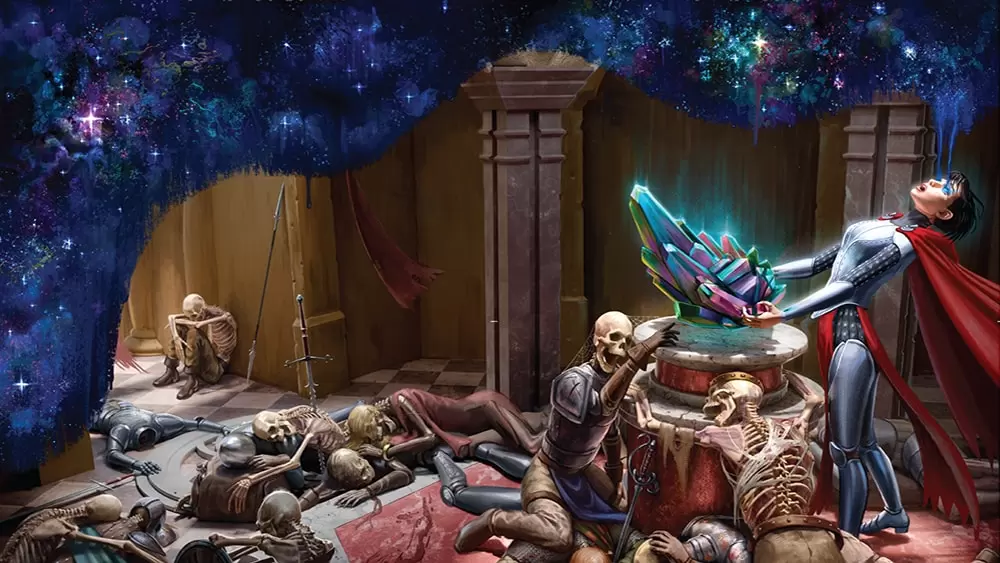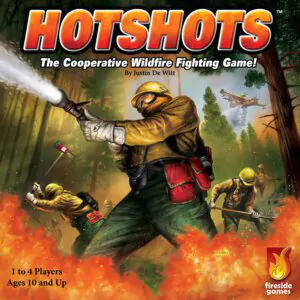
Publisher: Fireside Games
Designer: Justin DeWitt
Artists: Víctor Pérez Corbella and Chris Quilliams
Year: 2017
Genre: Push-your-luck dice game of wildfire fighting
Players: One to four players
Ages: 10+
Playing Time: Around sixty minutes
MSRP: $34.95
Outside the Box
***
I must say I’m always interested in checking out the latest releases from Fireside Games. Not only are their titles usually interesting and entertaining but Anne-Marie and Justin DeWitt are two of the nicest people you’ll meet in the industry. I was especially looking forward to checking out the company’s latest game, Hotshots, at this year’s Origins Game Fair but a slight production delay pushed the release to Gen Con. Thankfully, I received a review copy shortly after Gen Con and emphatically feel the game is certainly worth the wait.
In case you don’t know, a “hotshot” is a firefighter thoroughly trained in suppressing and extinguishing wildfires. Normally, a crew is made up of twenty members who work together as a team. The term hotshot is used since these teams are usually assigned to take on the most dangerous areas of the fire. Hotshots are looked upon by the firefighting community in the same way special forces are by the military.
In Hotshots, up to four players assume individual roles within the team as they aim to extinguish a wildfire before it consumes the forest. The players will mainly roll a set of custom dice as they look to exactly match the exact symbols on a burning forest tile. The firefighting tasks can eventually be made a bit easier if players roll extremely well and gain firebreaks and bonuses. Yet, the flames can spread around the board and keep the team on their toes.
As you can see in my Outside the Box video above, the components of Hotshots are very nice. The standees, markers, and dual sided tiles are thick cardboard and the plastic flame tokens are especially cool too. The custom dice faces are also cut and painted so they’ll stand up to repeated play. Each die shows one side featuring a chainsaw, a firefighter, a hose, a McLeod tool, a shovel, and a Pulaski tool; these symbols are the same as you’ll find on the forest tiles. The rules are straightforward, lavishly illustrated, and easily understood. All in all, another quality presentation from Fireside.
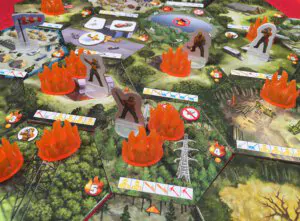
The forest layout is generated by randomly placing the nineteen terrain tiles in a hexagonal grid. You can actually increase the game’s challenge by using one of the additional layouts inspired by real national parks or even create your own. One side the tile will show the forest and what may occupy that area. These could represent the team’s staging area or supply cache, the airbase where vehicles are located, houses, campsites, an extremely vulnerable propane tank, just to name a few. Also located on these sides are flame icons with numbers within them (known as the scorch limit) as well as a series of six symbols players will look to match in order to extinguish flames.
The other side of a tile shows a burned out forest and when a tile becomes “scorched” it will be flipped to this side. If at any time a tile contains flame tokens equal to the tile’s limit it becomes scorched or, in other words, effectively destroyed. The players lose the game at any point eight tiles, or the team’s fire base, become scorched.
It’s important to look closely at each of these tiles because there might also be icons indicating how many flame tokens the tile begins the game with as well as dire consequences of that tile becoming scorched such as spreading flames to adjacent tiles or even costing a character their special ability.
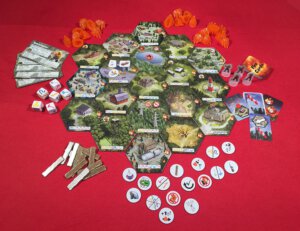
Once the tiles are laid out, the flame tokens placed on their starting tiles, the fire deck is created, and a wind indicator placed pointing north on the base camp, you’re ready to begin fighting the fire.
Players take turns doing what they can to prevent the fire from spreading as they also look to extinguish currently fires burning through the tiles. Normally, each player may move their firefighter up to two tiles, although they must stop in a tile if it is on fire. There also happens to be a single rough terrain tile which takes a player’s entire movement to enter or leave. Bonus reward tokens and the brush rig vehicle can also help move a character more than two spaces. Also the crew boss can move another firefighter one tile during their own turn.
Once a player has moved their firefighter they can either fight the fires in that tile, launch a one shot firefighting vehicle (airplane, helicopter, or brush rig) if they happen to be at the airbase, or recover lost dice from scorched tiles if they’re at the base camp. Mainly though, the players will be fighting fires in their tile.
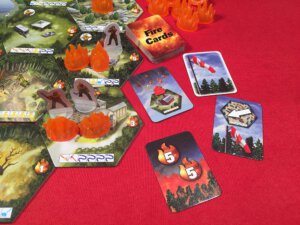
As long as the player matches symbols they may decide to reroll their remaining, non-matching dice in an attempt to gain more matches until they match all six. Of course, the sawyer and swamper can use their special abilities to change die faces each time they roll. A player is never forced to reroll their dice though and can stop in order to receive whatever benefits they gained with the dice they set aside. If a player doesn’t match any symbols on their initial roll though, or any subsequent roll, a blowup ensues. In the case of a blowup, all matching dice which were set aside are lost (thus gaining no benefits from the roll) and an additional flame token is added to the tile the firefighter is on.
Blowups can be especially nasty if that new flame token brings the fire to the scorch limit of the tile. Not only will the tile be flipped over to become scorched, and any detrimental effects of losing that tile immediately take place, but the players’ dice pool is decreased by the number of firefighters on that tile; as an example, if two firefighters had teamed up to tackle a tile and that tile gets scorched the players will only have four dice to roll on their turns until a player returns to he base camp and spends their turn returning the dice to the pool.
Thankfully, players can earn what’s known as support which will allow them to ignore a single blowup on their turn. A player can gain support if they’re battling fires on a tile located next to the lake, or if they have a special reward token which gives them support to spend, or if another firefighter is on the same tile. Support is cumulative as well so it can stack up for a player on their turn. In essence, one support allows the player to push-their-luck a single time without facing any consequences.
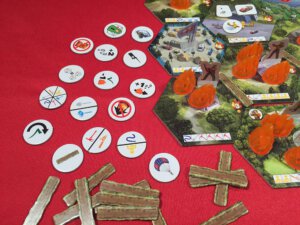
Once the player has moved their firefighter and taken their action (roll dice, dispatch a vehicle, or recover lost dice) they’ll finish their turn by drawing a card from the fire deck. The fire card will either spread flames or increase the fires already burning. In other words, fire cards never do anything good for the firefighters and simply come in different flavors and levels of bad news. The spotter is able to look at the top two cards of the deck, select one to play, and returns the other card to the top of the deck. This fire deck really provides a lot of twists and turns and brings the unpredictable nature of real world wildfires to the game play.
After a player has drawn a fire card and applied its effects their turn ends and it’s on to the next player. As previously mentioned, the game continues until either the players have extinguished all of the fires, eight tiles become scorched, or the base camp goes up in flames. The game moves along at a steady clip and, even with a full complement of four players, you won’t find Hotshots take longer than sixty minutes even as you’re just learning.
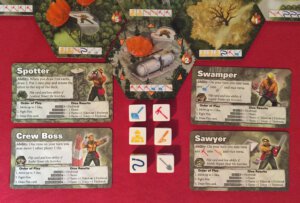
I really enjoyed Hotshots and have to say our youngest TGG correspondent, my nephew Cameron, absolutely loved the game; Cam happens to be a big fan of thematic, push-your-luck dice games in the first place. While there is a bit of rinse and repeat – the players essentially spend most of the time moving firefighters and rolling dice – there’s plenty of randomness with the board set up options, fire cards, and dice rolls to keep the proceedings fresh every time you play. I will say the spotter crew member feels like a bit of a let down seeing their special ability is only to pick one of two fire cards to play and the card they don’t select ends up taking place on the next player’s turn anyway. Granted, it’s realistic since the spotter shouldn’t be changing the future but simply giving the players a heads up. Yet, the spotter just seems to be the least fun crew member to play.
Strangely, during the five games we played in order to review Hotshots, we experienced some exceptionally good luck as we didn’t lose once. I could tell this had a lot more to do with luck than our careful planning or advanced strategizing as we were getting five or six symbols on our initial rolls. Sure, there were some touch and go moments that were pretty tense but we prevailed in the end. I’ll have to bet the next time we bring the game to the table we’ll get shellacked. Of course, the sheer amount of randomness will be a turn off for some gamers who dislike that sort of thing (especially those who are firmly in the camp of puzzle style Eurogames) but I think a whole lot of folks will really dig Hotshots. I was looking forward to Hotshots hitting the scene and I’m certainly not disappointed!
[rwp-review id=”0″]
- The Terror Beneath Horror RPG is Out in Print and PDF - Nov 22, 2024
- Ashes Without Number Roleplaying Game is Up on Kickstarter - Nov 22, 2024
- Dragonmeet to See the Return of RuneQuest: Sun Country from Chaosium Inc - Nov 22, 2024




